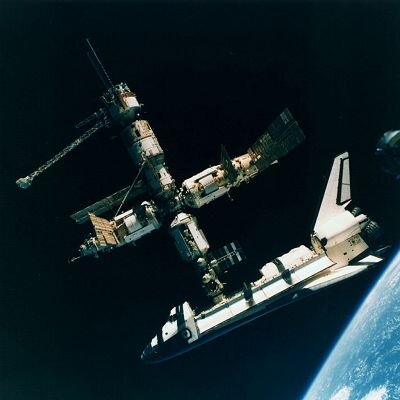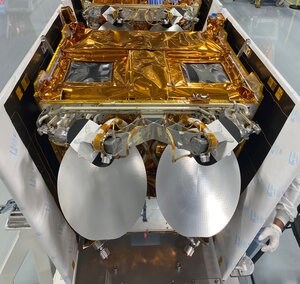From Brick Moon to space laboratory
Ever since humans first began to imagine space travel, space stations have been a popular theme. Ideas have been many and varied and often reflect the spirit of the time, remarkably many of the visionaries also showed remarkable foresight.
One of the first to mention space stations was the American clergyman and author Edward Everett Hale in his book The Brick Moon. One of his ideas was to use space to help sailors find their way across the seas. This was in 1869, just about the time when Jules Verne sent his protagonists around the moon.
The first to discuss a space station recognisable as such today was probably the Transylvanian-born German space pioneer Hermann Oberth. In 1923 he proposed a space station to be placed at an altitude of 1000 km that could be used for observing the Earth and the sky, supporting rescue operations, for meteorological and military observations and as a fuel depot for further space exploration. Oberth's station would be supplied by a fleet of smaller cargo rockets. It was up to one of his pupils, Werner von Braun, to realise many of Oberth's ideas.
At about the same time, two officers of the Austrian army, Baron Guido von Pirquet and Hermann Noordung, wrote about similar designs. Their space station would be powered by solar panels and Noordung was the first to calculate a geostationary orbit. His station was built in the shape of a toroid, similar to that of a doughnut; an idea that came to be widely used in science fiction.
Two cooks and four orderlies
Weightlessness was recognised as a problem very early on. The usual way to get around it was to spin the station, thus creating an artificial sense of gravity on the inside. The spinning wheel-like space station in 2001 – a Space Odyssey established a norm and counted Werner von Braun among its supporters.
In 1949, the British engineer H.E. Ross suggested sending up a space station in modules to be assembled in orbit. Unable to free himself from the spirit of the time, he included in the crew of 24 two cooks and four orderlies.
Then in 1969, a few years before the first space station was built, Gerard O'Neill, pilot, Apollo candidate and professor of physics, queried whether the surface of a planet was the ideal place to found space colonies. His idea was to build one hundred-kilometre-long cylinders that could be spun to create artificial gravity and house thousands or even millions of people. A worldwide organisation sprung up in O'Neill's footsteps: the L 5 Society, named after the point in the Earth–Moon system that O'Neill suggested would be the most suitable for his colonies.
The Soviets are first – again
NASA, founded in 1958, planned to launch a space station around 1970; had they succeeded the US would have been the first country to orbit a space station. However, they were not ready in time and the honour went instead to the Soviet Union as they launched Saljut-1 on 19 April 1971. Saljut-1 was 20 m long, 4 m in diameter, weighed 18 tonnes and had an effective volume of about 90 m3. The space station hosted a crew of one that during a 23-day visit worked through a series of scientific, engineering and observational experiments. Saljut-1 orbited the Earth for 6 months before being destroyed on re-entering the Earth's atmosphere.
Two years later on 14 May 1973, the American space station, Skylab was finally launched. Skylab was a much larger beast as it was 36 m long, 6 m in diameter and weighed 76 tonnes with a volume of 360 m3.
Skylab – pioneer with problems
The launch was not straightforward and came very close to being a complete disaster. The micro-meteorite shield that doubled as a sun block tore loose during launch, as did one of the solar panels. Debris from the shield pinned the remaining solar panel preventing it from opening fully, so that when Skylab reached orbit it was nearly powerless.
During their 28-day stay the first crew managed to make sufficient repairs to put the station in some semblance of working order, and also managed to carry out scientific experiments and observations. The second crew continued both the repairs and the scientific work and stayed on board for 59 days. On 16 November 1973 the third crew lifted off and stayed for a then remarkable 84 days. All three Skylab crews set new records for time spent in space.
Skylab was then supposed to power down and wait for the first Shuttle launch in 1979 but delays set in and the first Shuttle did not launch until 1981. Given its state of disrepair it was decided that no further measures could be justified and the station met its end on 11 July 1979 amid public outcry when it crashed and burned over the South Pacific. Most of the debris that reached the ground landed in Australia, which led to the US Government being fined $400 for litter by an Australian municipality.
Salyut and Mir

Meanwhile the Soviet Salyut programme continued with both civilian and military launches until the launch of Saljut-7 on 19 April 1982. During the programme, 72 crews, consisting of both Soviet and international cosmonauts, spent a total of 1697 days on board the Salyuts and many cosmonauts shattered the Skylab records for time in space, some many times over.
Mir, the successor to the Salyuts, was the first space station with international collaboration and a number of American and European astronauts visited the space station during its lifetime. Mir was also the first space station to be launched in modules, although the later Salyut versions had experimented with modularity.
The first Mir module was launched on 19 February 1986 and the last on 23 April 1996. Once fully constructed, Mir weighed around 130 tonnes and was 35 m long. In the early 1990s, what had by then become the Russian Federation decided it could no longer afford to keep Mir in space. On 23 March 2001 Mir entered the Earth’s atmosphere and its remnants crashed into the ocean.
By that time Al Gore, the American Vice President and Viktor Chernomyrdin, the Russian Prime Minister, had announced a collaboration that would eventually become the International Space Station, the ISS. In November 1998 the first ISS component was launched and the first real module, originally destined for Mir 2, on 12 July 2000. The first crew arrived just a few months later. Now, six years on, the ISS is to have its first Swedish crew member.















 Germany
Germany
 Austria
Austria
 Belgium
Belgium
 Denmark
Denmark
 Spain
Spain
 Estonia
Estonia
 Finland
Finland
 France
France
 Greece
Greece
 Hungary
Hungary
 Ireland
Ireland
 Italy
Italy
 Luxembourg
Luxembourg
 Norway
Norway
 The Netherlands
The Netherlands
 Poland
Poland
 Portugal
Portugal
 Czechia
Czechia
 Romania
Romania
 United Kingdom
United Kingdom
 Slovenia
Slovenia
 Sweden
Sweden
 Switzerland
Switzerland


























